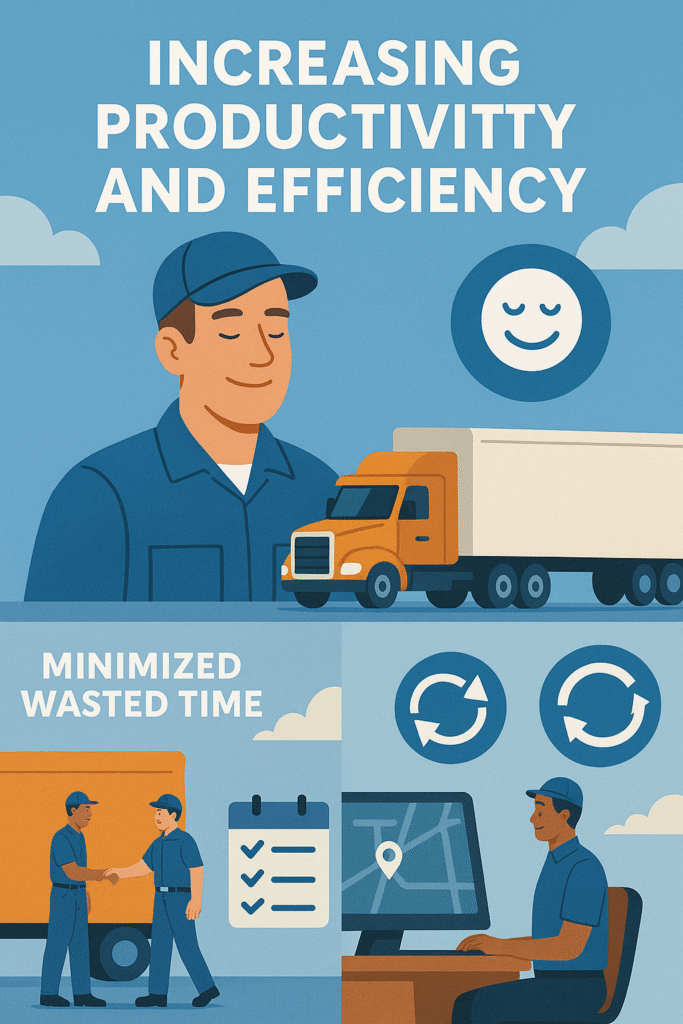Managing a truck driver workforce is crucial for every logistics company operating in the rapidly changing environment. Companies that carefully follow the transport regulations and take into account the time pressure alongside the long-distance travel issue are the ones that benefit from the flexible scheduling system the most. Flexible scheduling, apart from allowing drivers to better manage their time, also increases productivity, efficiency, operations performance, retention, and driver plus organizational overall satisfaction.
In this part, we demonstrate how flexibility can be introduced in the scheduling process of your transport business which will lead to excellent outcomes.
1. Flexible Scheduling for Drivers – A Quick Understanding
Flexible scheduling is about determining work calendars and routes that respond to both the business needs and the driver`s personal preferences. In contrast to the strict timeliness such as departure at 6 a.m., return by 6 p.m., flexibility may also:
- Start to use early or late shifts to cover personal matters.
- Offer split shifts or compressed hours (e.g., four 10-hour days).
- Implement drivers’ bidding or self-scheduling systems where they choose assignments.
- Suggest part-time, shortened or focused routes for better availability organization.
This assists both organizational operations and driver health. The ability to better manage one`s daily time translates to the truckers having more engagement and performing at a higher level.

2. An Overview of the Main Benefits
Here’s a quick overview of what flexible scheduling brings to the table:
| Benefit Category | What It Means for Drivers and Business |
| Time Management | Drivers can better balance work and personal life. |
| Productivity | Well-rested drivers are more alert and focused. |
| Efficiency | Tailored schedules reduce deadhead miles and downtime. |
| Operations | Smoother dispatching and route matching with real-time shifts. |
| Retention | Happy drivers stay longer, reducing turnover costs. |
| Satisfaction | Feeling valued and heard boosts morale and loyalty. |
3. Time Management and Driver Well-Being
Inconsistent schedules pose a constant challenge to the truck drivers struggling to maintain family, health, and work. When scheduling is not rigid anymore, drivers’ life becomes much easier:
- A young mother can choose shifts that begin early in the morning and let her leave by noon.
- Another driver can avoid traffic by driving overnight and come back well rested.
This, consequently, creates the balance between their work and personal life. When drivers are able to organize their time, their fatigue level goes down, and their job satisfaction increases. This in turn makes the roads safer — and creates a healthier and more stable workforce.

4. Increasing Productivity and Efficiency
The more flexible drivers are, the better they perform. Here are the reasons why:
- Relaxed & Happy Drivers: Flexible hours make drivers less tired. A well-rested driver is more alert and makes fewer errors, thus arrives quicker at the destination.
- Minimized Wasted Time: When flexible start and end times are applied, waiting at terminals/loading docks is diminished significantly.
- Evolved Dispatching: Fleet managers can dynamically assign drivers, based on real-time availability, thus reducing empty miles and enhancing load matching.
The result is that efficiency improvises radically — all the way from low-cost miles per route to acceleration of getting to the destination, to lift general productivity.
5. Streamlined Operations
The operational edge of flexible scheduling is huge:
- Flex in Demand: For example, if particular lanes or regions have an abrupt demand surge, flexible drivers can be on the right spot the fastest.
- Cross-training Capability: When drivers alternate routes/shifts, they gain new skills and the operations use it to remain flexible.
- Smart Dispatching: Incorporating flexible scheduling into the routing system gives dispatchers knowledge of available drivers, thus improving route assignments and cutting delays.
The better allocation of the assignments enhances on-time performance and, consequently, customer trust. Thus, you create a stronger logistics network.
6. Employee Retention and Lower Turnover Rates
The transportation industry is often plagued by driver turnover. A long-term view shows that flexibility is a powerful weapon for minimizing turnover:
- When drivers feel at home regarding their life, they tend to be less inclined to leave.
- Less turnover translates into fewer expenses for hiring, training, and onboarding.
- Having more experienced drivers leads to stronger relationships with clients and colleagues, which ultimately enhances the quality of operations.
The flexible culture could make a statement: we care about the driver as a human being not just an asset to the company.
7. Employee Satisfaction Triples When Drivers Are Flexible
The driver who is satisfied is the one who is productive. Flexible scheduling is a major contributor to:
- Work–Life Balance: Drivers who juggle family and personal issues feel more appreciated.
- Empowerment: Allowing inputs to scheduling increases satisfaction and commitment.
- Trust: The drivers feel that management trusts them, thus, this loyalty fosters open communication.
This positive cycle, in turn, keeps the entire workforce in line with the company goals — be it reduced delivery times, better compliance, or superior customer service.
8. Implementation Hints
Applying a flexible schedule means drawing up a clearly defined plan that is good. Implement the guidelines that you follow:
- Consult with Drivers: Consult the drivers about the hours, types of routes, and the scheduling they prefer and their opinions that form the basis for it.
- Pilot a Small Scale: To start with, In order to run on a flexible model in a single region or route, first implement it. Monitor the performance, feedback, and overall impact on operational practices.
- Tech Enablement: Employ the scheduling platforms that facilitate the drivers to set their own preferences and bid. The principal thing is the real-time data for the transparent availability.
- Dispatcher Training: The dispatchers are to be educated in the use of the tools for their survival in the variable field i.e pairing loads with driver access for proper routing.
- Define Limits and Rules: A vague flexible manner is not acceptable. Sticking with the specifics of the hours of service, safety requirements, and fair workload distribution is mandatory.
- Measure Relevant Metrics: The effectiveness of your program can be determined by the retention rate, the on-time deliveries count, the idle time amount, and the ratings given by the drivers.
9. “Trucking Talent” Mention (Seamless Insertion)
With a more flexible workforce, you will see that attracting Trucking Talent will become much simpler. The day drivers are informed about a respectful employer that offers time flexibility and flexible scheduling, they will be more likely to choose it over the competition. Thus, flexibility will not only be a key factor in the retention of your current truck drivers but it will also act as a recruitment advantage, helping you to attract quality Trucking Talent online.
10. Real-World Example (Hypothetical)
Let’s suppose HaulSmart Logistics opted for scheduling flexibility in one region:
- Drivers could bid on early (4 a.m.), mid (8 a.m.), or late (noon) starts.
- Some chose compressed 4-day weeks with 10-hour shifts.
- Idle time was cut by 15%.
- Driver turnover decreased from 40% to 25%.
- On-time performance saw a 10 percentage point increase.
These statistics illustrate that providing drivers with scheduling flexibility leads to better efficiency, operations, and satisfaction. That’s the way it grows loyalty and performance.
11. Brief Recap
Flexible scheduling is not just a trend — it’s a key strategic approach that needs to be in your toolset to manage your modern truck driver workforce more effectively. By correlating time management, productivity, and efficiency with the real human requirements, you create operations that are stronger, smarter, and more sustainable. The benefits stretch from the foot of the pyramid like retention, satisfaction, and operational agility — and they make you attractive to better Trucking Talent.







